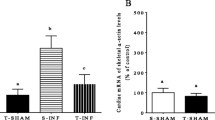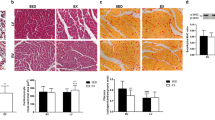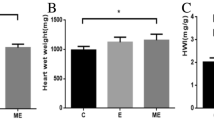Abstract
The effect of exercise training on myocardial Na+/H+ exchanger-1 (NHE1) protein expression was examined. Adult female Sprague–Dawley rats were randomly divided into sedentary (S; n = 8) and exercised (E; n = 9) groups. Twenty-four hours after the last exercise bout, hearts were weighed and connected to an isolated perfused working heart apparatus for evaluation of cardiac functional performance. Heart weight and heart weight/body weight from E rats was significantly increased by 7.1 and 7.2 % (P < 0.05), respectively, compared with S hearts. The E hearts displayed 15 % greater cardiac output and 35 % external cardiac work compared with the S group at both low and high workloads (P < 0.05 for both parameters). Left ventricular tissue from the same hearts was homogenized and NHE1 and Na+/Ca2+ exchanger (NCX) content determined by Western blotting. E hearts had a 38 % (P < 0.001) reduction in NHE1 content related to S hearts, and there was no difference in NCX content between groups. Cytochrome c oxidase activity in plantaris increased by 100 % (P < 0.05) and was assessed as a marker of mitochondria content and to verify training status. Our data indicate that exercise training at an intensity that results in cardiac hypertrophy and improved performance is accompanied by decreased NHE1 content in heart.


Similar content being viewed by others
References
Akram S, Teong HF, Fliegel L, Pervaiz S, Clement MV (2006) Reactive oxygen species-mediated regulation of the Na+–H+ exchanger 1 gene expression connects intracellular redox status with cells’ sensitivity to death triggers. Cell Death Differ 13:628–641
Aldakkak M, Stowe DF, Heisner JS, Spence M, Camara AK (2008) Enhanced Na+/H+ exchange during ischemia and reperfusion impairs mitochondrial bioenergetics and myocardial function. J Cardiovasc Pharmacol 52:236–244
Brown DA, Moore RL (2007) Perspectives in innate and acquired cardioprotection: cardioprotection acquired through exercise. J Appl Physiol 103:1894–1899
Chen L, Chen CX, Gan XT, Beier N, Scholz W, Karmazyn M (2004) Inhibition and reversal of myocardial infarction-induced hypertrophy and heart failure by NHE-1 inhibition. Am J Physiol Heart Circ Physiol 286:H381–H387
Cingolani HE, Ennis IL (2007) Sodium-hydrogen exchanger, cardiac overload, and myocardial hypertrophy. Circulation 115:1090–1100
Cingolani HE, Rebolledo OR, Portiansky EL, Perez NG, Camilion de Hurtado MC (2003) Regression of hypertensive myocardial fibrosis by Na(+)/H(+) exchange inhibition. Hypertension 41:373–377
Cohn JN, Bristow MR, Chien KR, Colucci WS, Frazier OH, Leinwand LA, Lorell BH, Moss AJ, Sonnenblick EH, Walsh RA, Mockrin SC, Reinlib L (1997) Report of the National Heart, Lung, and Blood Institute Special Emphasis Panel on Heart Failure Research. Circulation 95:766–770
Cooper TG (1977) The tools of biochemistry. Wiley, New York
Ennis IL, Escudero EM, Console GM, Camihort G, Dumm CG, Seidler RW, Camilion de Hurtado MC, Cingolani HE (2003) Regression of isoproterenol-induced cardiac hypertrophy by Na+/H+ exchanger inhibition. Hypertension 41:1324–1329
Fagard RH (1997) Impact of different sports and training on cardiac structure and function. Cardiol Clin 15:397–412
Garciarena CD, Pinilla OA, Nolly MB, Laguens RP, Escudero EM, Cingolani HE, Ennis IL (2009) Endurance training in the spontaneously hypertensive rat: conversion of pathological into physiological cardiac hypertrophy. Hypertension 53:708–714
Harris MB, Starnes JW (2001) Effects of body temperature during exercise training on myocardial adaptations. Am J Physiol Heart Circ Physiol 280:H2271–H2280
Haworth RS, McCann C, Snabaitis AK, Roberts NA, Avkiran M (2003) Stimulation of the plasma membrane Na+/H+ exchanger NHE1 by sustained intracellular acidosis. Evidence for a novel mechanism mediated by the ERK pathway. J Biol Chem 278:31676–31684
Iaia FM, Thomassen M, Kolding H, Gunnarsson T, Wendell J, Rostgaard T, Nordsborg N, Krustrup P, Nybo L, Hellsten Y, Bangsbo J (2008) Reduced volume but increased training intensity elevates muscle Na+–K+ pump alpha1-subunit and NHE1 expression as well as short-term work capacity in humans. Am J Physiol Regul Integr Comp Physiol 294:R966–R974
Iemitsu M, Maeda S, Jesmin S, Otsuki T, Kasuya Y, Miyauchi T (2006) Activation pattern of MAPK signaling in the hearts of trained and untrained rats following a single bout of exercise. J Appl Physiol 101:151–163
Imahashi K, Mraiche F, Steenbergen C, Murphy E, Fliegel L (2007) Overexpression of the Na+/H+ exchanger and ischemia-reperfusion injury in the myocardium. Am J Physiol Heart Circ Physiol 292:H2237–H2247
Javadov S, Baetz D, Rajapurohitam V, Zeidan A, Kirshenbaum LA, Karmazyn M (2006) Antihypertrophic effect of Na+/H+ exchanger isoform 1 inhibition is mediated by reduced mitogen-activated protein kinase activation secondary to improved mitochondrial integrity and decreased generation of mitochondrial-derived reactive oxygen species. J Pharmacol Exp Ther 317:1036–1043
Javadov S, Choi A, Rajapurohitam V, Zeidan A, Basnakian AG, Karmazyn M (2008) NHE-1 inhibition-induced cardioprotection against ischaemia/reperfusion is associated with attenuation of the mitochondrial permeability transition. Cardiovasc Res 77:416–424
Javadov S, Purdham DM, Zeidan A, Karmazyn M (2006) NHE-1 inhibition improves cardiac mitochondrial function through regulation of mitochondrial biogenesis during postinfarction remodeling. Am J Physiol Heart Circ Physiol 291:H1722–H1730
Judge S, Jang YM, Smith A, Hagen T, Leeuwenburgh C (2005) Age-associated increases in oxidative stress and antioxidant enzyme activities in cardiac interfibrillar mitochondria: implications for the mitochondrial theory of aging. FASEB J 19:419–421
Juel C (2000) Expression of the Na(+)/H(+) exchanger isoform NHE1 in rat skeletal muscle and effect of training. Acta Physiol Scand 170:59–63
Juel C, Klarskov C, Nielsen JJ, Krustrup P, Mohr M, Bangsbo J (2004) Effect of high-intensity intermittent training on lactate and H+ release from human skeletal muscle. Am J Physiol Endocrinol Metab 286:E245–E251
Kilic A, Rajapurohitam V, Sandberg SM, Zeidan A, Hunter JC, Said Faruq N, Lee CY, Burnett JC Jr, Karmazyn M (2010) A novel chimeric natriuretic peptide reduces cardiomyocyte hypertrophy through the NHE-1-calcineurin pathway. Cardiovasc Res 88:434–442
Kohlhaas M, Liu T, Knopp A, Zeller T, Ong MF, Bohm M, O’Rourke B, Maack C (2010) Elevated cytosolic Na+ increases mitochondrial formation of reactive oxygen species in failing cardiac myocytes. Circulation 121:1606–1613
Mace LC, Palmer BM, Brown DA, Jew KN, Lynch JM, Glunt JM, Parsons TA, Cheung JY, Moore RL (2003) Influence of age and run training on cardiac Na+/Ca2+ exchange. J Appl Physiol 95:1994–2003
Mandroukas A, Metaxas TI, Heller J, Vamvakoudis E, Christoulas K, Riganas CS, Sendelides T, Stefanidis P, Kotoglou K, Karamouzis I, Mandroukas K (2011) The effect of different exercise-testing protocols on atrial natriuretic peptide. Clin Physiol Funct Imaging 31:5–10
McMullen JR, Shioi T, Huang WY, Zhang L, Tarnavski O, Bisping E, Schinke M, Kong S, Sherwood MC, Brown J, Riggi L, Kang PM, Izumo S (2004) The insulin-like growth factor 1 receptor induces physiological heart growth via the phosphoinositide 3-kinase(p110alpha) pathway. J Biol Chem 279:4782–4793
Mentzer RM Jr, Bartels C, Bolli R, Boyce S, Buckberg GD, Chaitman B, Haverich A, Knight J, Menasche P, Myers ML, Nicolau J, Simoons M, Thulin L, Weisel RD (2008) Sodium-hydrogen exchange inhibition by cariporide to reduce the risk of ischemic cardiac events in patients undergoing coronary artery bypass grafting: results of the EXPEDITION study. Ann Thorac Surg 85:1261–1270
Nakamura TY, Iwata Y, Arai Y, Komamura K, Wakabayashi S (2008) Activation of Na+/H+ exchanger 1 is sufficient to generate Ca2+ signals that induce cardiac hypertrophy and heart failure. Circ Res 103:891–899
Nelson MJ, Harris MB, Boluyt MO, Hwang HS, Starnes JW (2011) Effect of N-2-mercaptopropionyl glycine on exercise-induced cardiac adaptations. Am J Physiol Regul Integr Comp Physiol 300:R993–R1000
Oliveira RS, Ferreira JC, Gomes ER, Paixao NA, Rolim NP, Medeiros A, Guatimosim S, Brum PC (2009) Cardiac anti-remodelling effect of aerobic training is associated with a reduction in the calcineurin/NFAT signalling pathway in heart failure mice. J Physiol 587:3899–3910
Pedersen SF, O’Donnell ME, Anderson SE, Cala PM (2006) Physiology and pathophysiology of Na+/H+ exchange and Na+–K+–2Cl− cotransport in the heart, brain, and blood. Am J Physiol Regul Integr Comp Physiol 291:R1–R25
Powers SK, Quindry JC, Kavazis AN (2008) Exercise-induced cardioprotection against myocardial ischemia-reperfusion injury. Free Radic Biol Med 44:193–201
Pretorius L, Owen KL, Jennings GL, McMullen JR (2008) Promoting physiological hypertrophy in the failing heart. Clin Exp Pharmacol Physiol 35:438–441
Rumsey WL, Kendrick ZV, Starnes JW (1987) Bioenergetics in the aging Fischer 344 rat: effects of exercise and food restriction. Exp Gerontol 22:271–287
Shibata M, Takeshita D, Obata K, Mitsuyama S, Ito H, Zhang GX, Takaki M (2011) NHE-1 participates in isoproterenol-induced downregulation of SERCA2a and development of cardiac remodeling in rat hearts. Am J Physiol Heart Circ Physiol 301:H2154–H2160
Starnes JW, Barnes BD, Olsen ME (2007) Exercise training decreases rat heart mitochondria free radical generation but does not prevent Ca2+-induced dysfunction. J Appl Physiol 102:1793–1798
Starnes JW, Wilson DF, Erecinska M (1985) Substrate dependence of metabolic state and coronary flow in perfused rat heart. Am J Physiol 249:H799–H806
Taylor RP, Harris MB, Starnes JW (1999) Acute exercise can improve cardioprotection without increasing heat shock protein content. Am J Physiol 276:H1098–H1102
Wang Y, Meyer JW, Ashraf M, Shull GE (2003) Mice with a null mutation in the NHE1 Na+–H+ exchanger are resistant to cardiac ischemia-reperfusion injury. Circ Res 93:776–782
Wilkins BJ, Dai YS, Bueno OF, Parsons SA, Xu J, Plank DM, Jones F, Kimball TR, Molkentin JD (2004) Calcineurin/NFAT coupling participates in pathological, but not physiological, cardiac hypertrophy. Circ Res 94:110–118
Wisloff U, Loennechen JP, Falck G, Beisvag V, Currie S, Smith G, Ellingsen O (2001) Increased contractility and calcium sensitivity in cardiac myocytes isolated from endurance trained rats. Cardiovasc Res 50:495–508
Author information
Authors and Affiliations
Corresponding author
Rights and permissions
About this article
Cite this article
Feger, B.J., Starnes, J.W. Myocardial Na+/H+ exchanger-1 (NHE1) content is decreased by exercise training. J Physiol Biochem 69, 305–312 (2013). https://doi.org/10.1007/s13105-012-0214-7
Received:
Accepted:
Published:
Issue Date:
DOI: https://doi.org/10.1007/s13105-012-0214-7




